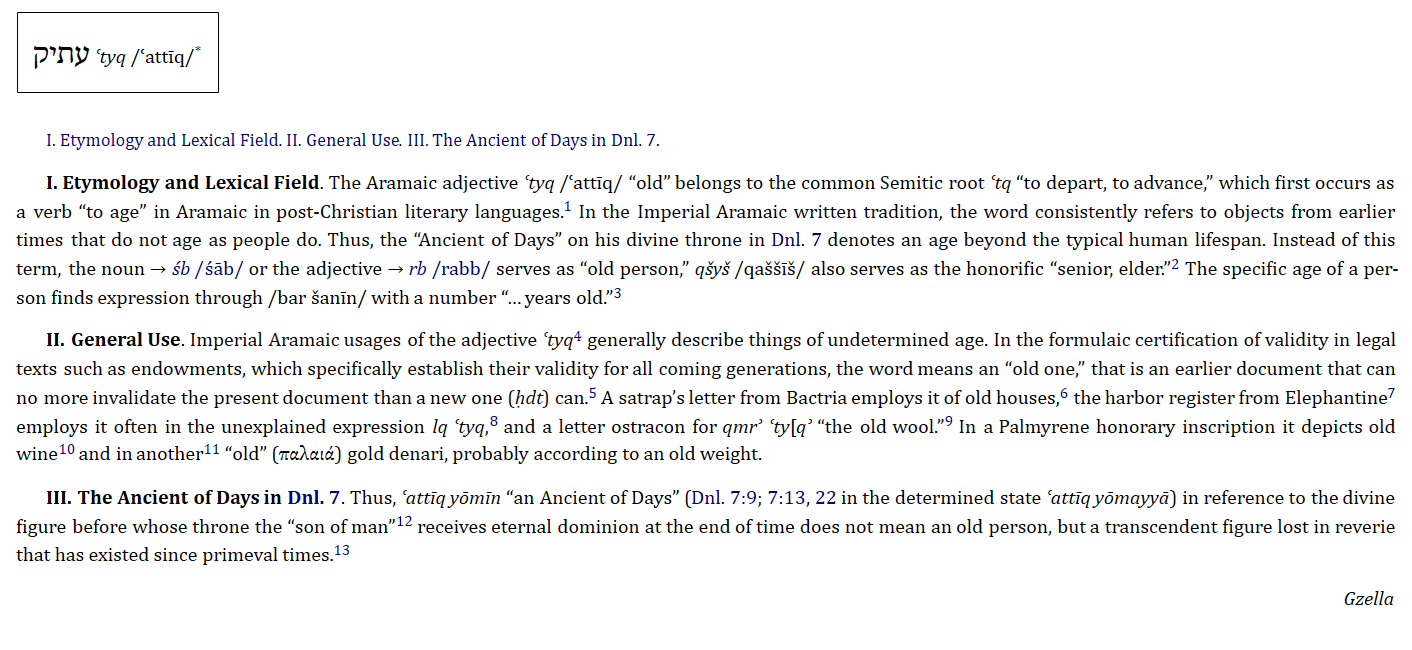Definition of Aramaic עתיק ("Ancient") in Theological Dictionary of the Old Testament.
- Type
- Book
- Source
- Holger Gzella Non-LDS
- Hearsay
- Secondary
- Reference
Holger Gzella, “עתיק,” in Theological Dictionary of the Old Testament, ed. Holger Gzella, 16 vols. (trans. Mark E. Biddle; Grand Rapids, Michigan: Eerdmans, 2018), 16:600-1 (Logos edition)
- Scribe/Publisher
- Logos, Eerdmans
- People
- Holger Gzella
- Audience
- Reading Public
- Transcription
I. Etymology and Lexical Field. The Aramaic adjective ʿtyq /ʿattīq/ “old” belongs to the common Semitic root ʿtq “to depart, to advance,” which first occurs as a verb “to age” in Aramaic in post-Christian literary languages. In the Imperial Aramaic written tradition, the word consistently refers to objects from earlier times that do not age as people do. Thus, the “Ancient of Days” on his divine throne in Dnl. 7 denotes an age beyond the typical human lifespan. Instead of this term, the noun → śb /śāb/ or the adjective → rb /rabb/ serves as “old person,” qšyš /qaššīš/ also serves as the honorific “senior, elder.” The specific age of a person finds expression through /bar šanīn/ with a number “… years old.”
II. General Use. Imperial Aramaic usages of the adjective ʿtyq generally describe things of undetermined age. In the formulaic certification of validity in legal texts such as endowments, which specifically establish their validity for all coming generations, the word means an “old one,” that is an earlier document that can no more invalidate the present document than a new one (ḥdt) can. A satrap’s letter from Bactria employs it of old houses, the harbor register from Elephantine employs it often in the unexplained expression lq ʿtyq, and a letter ostracon for qmrʾ ʿty[qʾ “the old wool.” In a Palmyrene honorary inscription it depicts old wine and in another “old” (παλαιά) gold denari, probably according to an old weight.
III. The Ancient of Days in Dnl. 7. Thus, ʿattīq yōmīn “an Ancient of Days” (Dnl. 7:9; 7:13, 22 in the determined state ʿattīq yōmayyā) in reference to the divine figure before whose throne the “son of man” receives eternal dominion at the end of time does not mean an old person, but a transcendent figure lost in reverie that has existed since primeval times.
- Citations in Mormonr Qnas
The B. H. Roberts Foundation is not owned by, operated by, or affiliated with the Church of Jesus Christ of Latter-day Saints.

